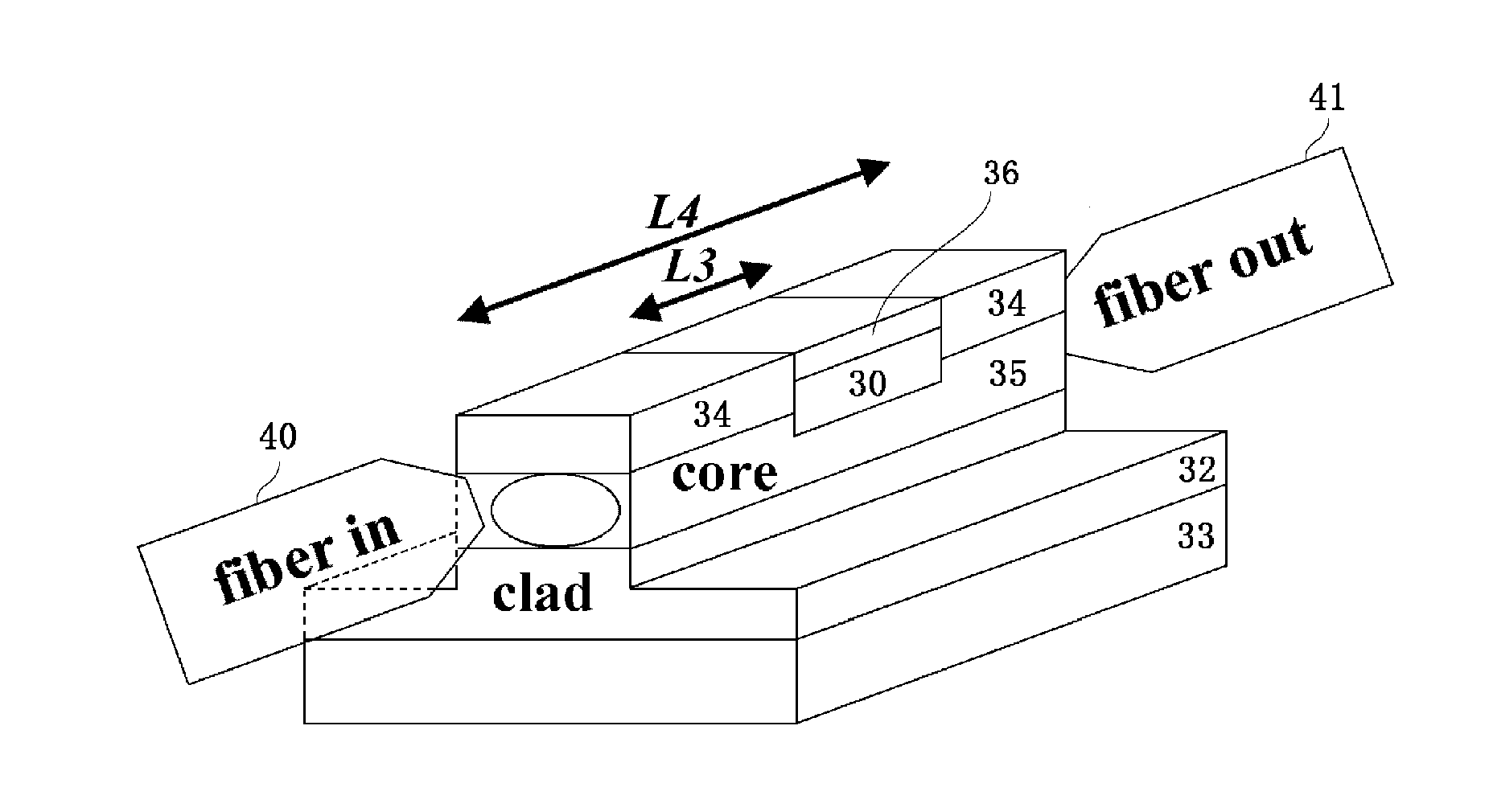Optical device using a plasmonic waveguide, and optical isolator
a technology of optical isolators and optical elements, which is applied in the direction of optical waveguide light guides, instruments, and high-speed optical amplifiers. it is difficult to grow magnetic garnets on substrates, and there is no report of any example in which other optical components are integrated on those semiconductors
- Summary
- Abstract
- Description
- Claims
- Application Information
AI Technical Summary
Benefits of technology
Problems solved by technology
Method used
Image
Examples
first embodiment
[0066]This embodiment relates to a plasmonic waveguide of three layers composed of Co / SiO2 / Si. This embodiment is described, with referring to FIGS. 2a) and 2b). FIG. 2a) is a diagram showing a structure of the plasmonic waveguide that was fabricated on a Si substrate. A SiO2 layer was interposed between the Si substrate and a Co layer. FIG. 2b) is a graph showing the results of a propagation distance where plasmons attenuated to 1 / e (right-side vertical axis) and a magneto-optical figure-of-merit (left-side vertical axis), each to the layer thickness of SiO2. In FIG. 2a), a magnetic field was applied to perpendicularly to a propagation direction of the plasmons. FIG. 2a) is a diagram showing the case where light entered from left on the drawing plane, and the direction of magnetization of the ferromagnetic metal layer Co was one perpendicularly entering the drawing plane in FIG. 2a) (i.e. a forward direction). This is an example of using light of wavelength 1,550 nm. In FIG. 2b), a...
second embodiment
[0071]This embodiment relates to a plasmonic waveguide of three layers composed of Co / MgO / Si. This embodiment is described, with referring to FIGS. 3a) and 3b). FIG. 3a) is a diagram showing a structure of the plasmonic waveguide that was fabricated on a Si substrate. A MgO layer was interposed between the Si substrate and a Co layer. FIG. 3b) is a graph showing the results of a propagation distance where plasmons attenuated to lie (right-side vertical axis) and a magneto-optical figure-of-merit (left-side vertical axis), each to the layer thickness of MgO. Similar to the first embodiment, in FIG. 3a), a magnetic field was applied to perpendicularly to a propagation direction of the plasmons. This is an example of using light of wavelength 1,550 nm. When the layer thickness of MgO approached the range of from 9.6 nm to 595 nm, the magneto-optical figure-of-merit sharply enhanced. In this embodiment, the plasmonic waveguide has an excellent performance as an optical isolator, when th...
third embodiment
[0075]This embodiment relates to a plasmonic waveguide of three layers composed of Fe / SiO2 / Si. This embodiment is described, with referring to FIGS. 4a) and 4b). FIG. 4a) is a diagram showing a structure of the plasmonic waveguide that was fabricated on a Si substrate. A SiO2 layer was interposed between the Si substrate and a Fe layer. FIG. 4b) is a graph showing the results of a propagation distance where plasmons attenuated to 1 / e (right-side vertical axis) and a magneto-optical figure-of-merit (left-side vertical axis), each to the layer thickness of the SiO2 layer. Similar to the first embodiment, in FIG. 4a), a magnetic field was applied to perpendicularly to a propagation direction of the plasmons. This is an example of using light of wavelength 1,550 nm. When the layer thickness of the SiO2 layer approached the range of from 8.4 nm to 600 nm, the magneto-optical figure-of-merit sharply enhanced. In this embodiment, the plasmonic waveguide has an excellent performance as an o...
PUM
 Login to View More
Login to View More Abstract
Description
Claims
Application Information
 Login to View More
Login to View More - R&D
- Intellectual Property
- Life Sciences
- Materials
- Tech Scout
- Unparalleled Data Quality
- Higher Quality Content
- 60% Fewer Hallucinations
Browse by: Latest US Patents, China's latest patents, Technical Efficacy Thesaurus, Application Domain, Technology Topic, Popular Technical Reports.
© 2025 PatSnap. All rights reserved.Legal|Privacy policy|Modern Slavery Act Transparency Statement|Sitemap|About US| Contact US: help@patsnap.com



